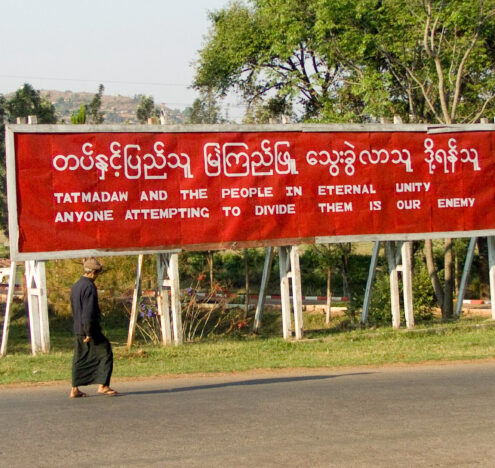“You have ignited a(n accidental) nuclear war. And no, there is no animated display of a mushroom cloud with parts of bodies flying through the air. We do not reward failure.”
So read the Game Over screen of “Balance of Power,” a 1985 grand strategy game where the player, controlling either the United States or the Soviet Union, attempts to outmaneuver their rival without provoking an apocalyptic nuclear war. The designer, Chris Crawford, didn’t want players to miss the stakes of his game. His famous Game Over message was so blunt that it offended some players, including author Orson Scott Card, who claimed “Balance of Power isn’t a game, it’s propaganda.”
Perhaps “Balance of Power” was propaganda, but if so, it wasn’t alone. Any video game that claims to simulate the real world is inherently making a social statement. Sometimes the message might be deliberate, like the first-person-shooter “America’s Army” (designed to boost military recruitment), or incidental, like “Grand Theft Auto” with its anarchic and crime-ridden hellscape. Grand strategy games are no different. The Council on Foreign Relations even designed its own video game, “Convene the Council,” to teach young people about the realities and tradeoffs of diplomacy. Given the immense popularity of strategy games, it’s worth taking a closer look into how they chose to portray the world.
Theories of International Relations
First, some theory. Over the years, scholars have built up a formidable number of different models to suggest how international politics functions. Today, the two most influential are liberalism and realism. Liberals see the globe as bound together by a cooperative system of rules and norms. Realists, on the other hand, are the kind of people who consider “Machiavellian” a compliment. Realists think that treaties, trade, and treacly optimism are all less important than power and national interest.
The vast majority of grand strategy games fit into the realism school of thought, encouraging countries to engage in direct competition over land and resources. The lone exceptions are “Civilization V” and “Civilization VI,” the most recent iterations of the famous strategy game franchise. “Civilization” is notable in that it offers multiple pathways to win the game. Players can triumph by being the most scientifically advanced nation, possessing the dominant culture, heading the strongest alliance network, or by simple military domination. “Civilization” even features a powerful United Nations, and offers a variety of ways for countries to collaborate in mutually beneficial ways. As we shall see, “Civilization” (and its close imitator “Endless Space”) features a degree of multilateralism that makes it something of an outlier in grand strategy games.
Realism is a bit more complicated. There are two main types of realists: defensive realists and offensive realists. Defensive realists like Stephen Walt believe that, in general, states would rather stick with the status quo than embark on risky aggression. They point to structural factors, like the difficulty of exploiting seized territory and the tendency of other states to unite against common enemies, as reasons for states to be content with what they have. Wars still happen, of course, but aggression is rarely in a state’s interest.
Offensive realists, on the other hand, believe that states attempt to maximize their own power at the expense of others. There is no such thing as being “secure enough.” As chief offensive realist John Mearsheimer puts it in his most famous book, “Great powers recognize that the best way to ensure their security is to achieve hegemony now, thus eliminating any possibility of a challenge by another great power.” Strategically speaking, the best defense is a good offense.
An Aggressive Paradox
Where do grand strategy games fall between defensive and offensive realism? Let’s take Swedish developer Paradox Interactive’s “Europa Universalis IV” (EU4), one of the most popular and sophisticated grand strategy games. Like all Paradox games, and in marked contrast to “Civilization,” EU4 offers a “sandbox experience”. Without any official win conditions, players are free to avoid military expansion and focus on peacefully developing the territory they already have (“playing tall” in the lexicon of the community), or they can engage in “map painting,” expanding as quickly as possible in a decidedly Mearsheimer-esque way.
Unfortunately, the game’s mechanics strongly incentivize constant aggression. Expansion is easy; once you take land, you can incorporate it into your territory within a few years, leaving you stronger than ever. EU4 countries have a tendency to snowball, growing at a faster and faster pace until they literally take over the entire world. It may have come from mild-mannered Sweden, but EU4 is an offensive realist’s paradise.
With the exception of the “Civilization” and “Endless Space” games, all of the top twenty most played games on the platform Steam follow a simple expansive cycle. Players control land, which provides income. Most of that money goes into armies, which swiftly conquer more land. That land is easy to incorporate and exploit, and soon produces more income and thus the cycle continues on and on until the players achieve hegemonic power or the game gets so easy as to be boring.
It is long past time for video games to portray a variety of theories of International Relations, not just a single Johnny-come-lately.
It’s not hard to understand why strategy games overwhelmingly incentivize aggression. Violence sells. Instability and constant warfare make the game more exciting and give the player a sense of accomplishment when they quickly expand their territory. On the other hand, there’s no reason to think that players wouldn’t enjoy other sorts of IR models. Many of the world’s most popular games, from “Candy Crush” to “Tetris,” involve no ultimate victory, but the staving off of possible disasters in the interest of the status quo. That’s not a bad metaphor for much of the business of statecraft.
If you had to pick one IR theory as the basis of 90% of grand strategy games, offensive realism would be a strange choice. The main book on the subject, “The Tragedy of Great Power Politics,” came out in just 2001. Bizarrely enough, video game designers illustrated the theory before academics did. Moreover, it remains a highly contested theory, with Mearsheimer himself being one of the most divisive figures in IR scholarship. It is long past time for video games to portray a variety of theories of International Relations, not just a single Johnny-come-lately.
Virtual Game, Real Impacts
Video games have the power to shape reality. The young Americans who will make up the next generation of foreign policy thinkers are deeply immersed in strategy games, and gaming communities have already proven themselves to be a hub of major national security leaks. I’m not saying that games should say something in particular — I want them to say everything. That includes liberalism games built around balancing military affairs with trade and cooperation, and defensive realist games based around preventing the hegemony of others, as opposed to becoming a hegemon yourself. As it is, the genre overwhelmingly favors one rather niche theory. It’s as though every cooking show dealt exclusively in Danish lutefisk, or if painting software were only capable of producing pointillism. The world is complicated and contradictory. We should not be afraid of approaching it with more than one theory.





















